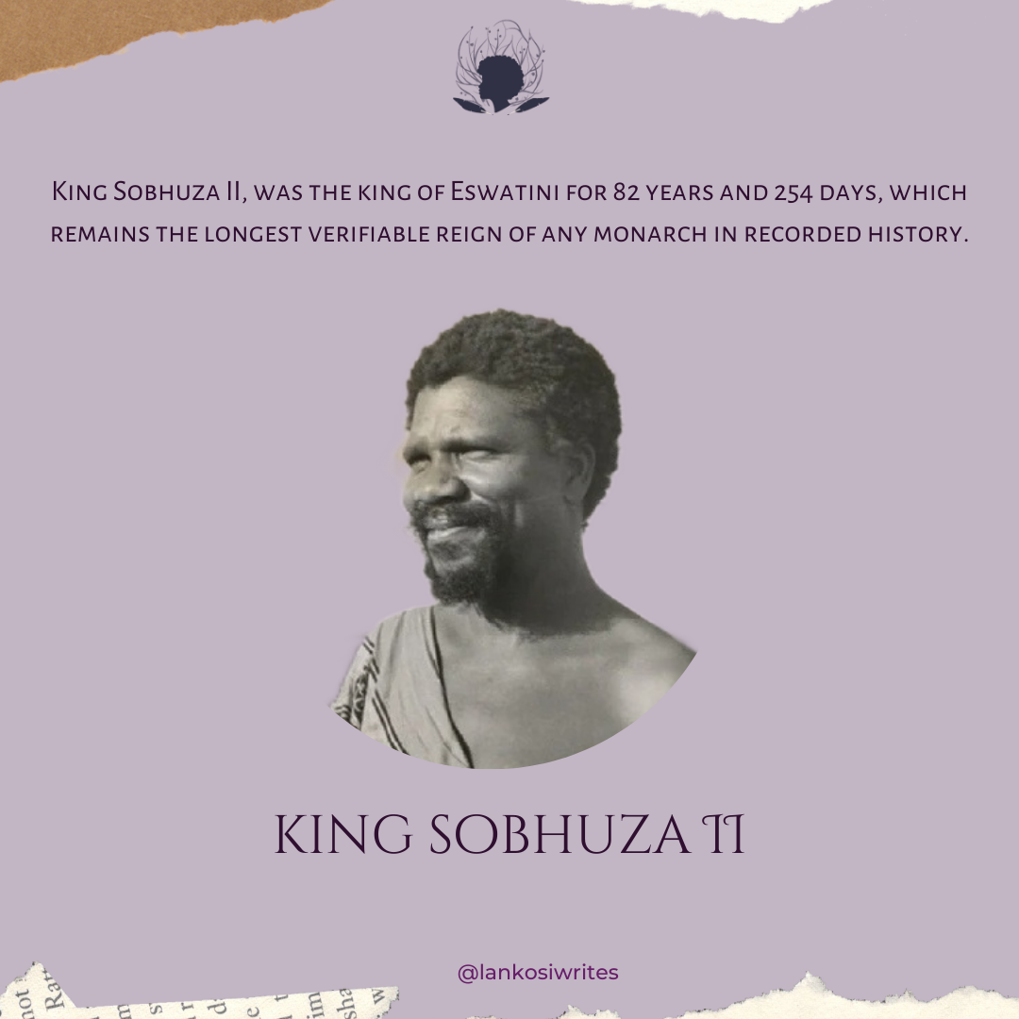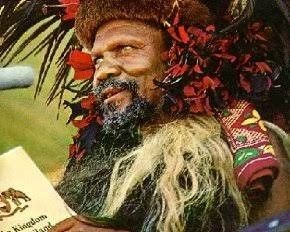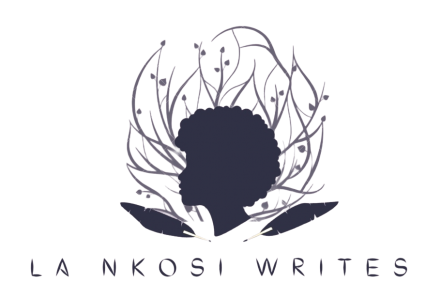
King Sobhuza II, was the king of Eswatini for 82 years and 254 days, which remains the longest verifiable reign of any monarch in recorded history.
His Early Life
23-year-old, King Ngwane V , father to King Sobhuza II took his last breath during an Incwala Festival held in February 1899. A few months after his passing, his wife Queen Lomawa Ndwandwe welcomed their son into the world at the Zombodze Royal Residence on the 22nd of July. The young prince was designated as King by the elders on September 10 1899, under his grandmother Queen Labotsibeni Gwamile Mdluli’s regency with the assistance of her son Prince Malunge, who led the Nation until the young monarch was of age.
The Queen regent saw to it that the future king of the kingdom of Eswatini receive quality education, by constructing a new national school. As a child young king Sobhuza II attended the Swazi National School. He continued with his Secondary schooling at the Lovedale Institute located in the Cape Province of South Africa for a period of two years. Lastly, he studied anthropology in Great Britain. The young king was not only receiving quality education, he now had a clear picture and understanding of the knowledge system from the West, on top of what he already knew about his people traditionally.
This was during a time when the European colonizers were expanding their grip and influence across the Mother Continent, in 1903 Eswatini was now under the rule of the British Government, their administration was then transferred to the High Commissioner in 1906 who was now responsible for Basotholand, Bechuanaland & Swaziland. The partitions proclamation introduced in 1907 ceded sections of land to European settlers, which would become a challenge for the new king’s reign.
Becoming The King – Paramount Chief of Eswatini
On the 22nd of December 1921, the young king was installed as the paramount chief of the Swazi, due to his Kingship title being ignored by the British, according to them, they did not recognize him as king at the time-this led to him putting together a petition to have the partitions proclamation overturned. The king then made his way to London in 1922 with the hopes of doing away with the partitions’ proclamation but was unsuccessful in his attempt to do so, but this did not stop him from ensuring that he secured the Independence of his kingdom and people.
During World War II, the King made a second attempt to overturn the partitions’ proclamation which was a success because he got the Brits to commit to buying back the land from settlers and returning it to the people of Eswatini, and in exchange, they would have the support of the Swazi people. During the final stages of the war King Sobhuza II, would be declared as the ‘Native Authority’ within the Borders of Eswatini, this gave him an unprecedented level of power in what was now a ‘British Colony’, because they were still in charge, and they wanted him to report to the British High Commissioner. They let him rule as king, but they only did so for ceremonial and traditional reasons, because he was deemed as the traditional head of the Swazi Nation. When the war came to an end, it became clear that a decision was to be made regarding the three territories that belonged to the Brits in the Southern African Region. In 1910 the plan to incorporate the three regions into the union of South Africa was not fruitful due to the emergence of the apartheid government in South Africa.
The South African government became polarized and the minority white group was in charge of the country’s governance. In 1948 when the National Party was pushing its campaign for the introduction of the apartheid regime, the British government saw that their doom would trickle in should they continue with passing down their high commission territories to South Africa.
During the late 1960s, the Swazi nation began to prepare for their independence, the British were also open to this, but they were gunning for the formation of a parliamentary system
with a constitutional monarchy in Eswatini. Whereas the people of Eswatini disagreed with the view because they wanted to do away with the British rule, this then led to the birth of several associations and parties who were eager to voice their outrage and distaste for being under the rule of the British, finding ways to embark on a journey to securing their freedom. Two commissions were held in London with representatives of the:
– European Advisory Council, which was a body created to represent the rights of white settlers in Eswatini to the British High Commissioner.
–Swazi National Council, which served as the King’s advisor where traditional tribal matters were a concern.
–Swaziland Progressive Party, which represented the educated elite who felt alienated by traditional tribal rule.
–Ngwane National Liberatory Congress, who advocated for a democracy with a constitutional monarchy.
In 1964, to ensure that his hold over the kingdom was solid King Sobhuza II, and a number of his prominent supporters formed a political party called the Imbokodvo National Movement which won all parliamentary seats during the 1967 pre-independence elections with the backing of, the white settler united Swaziland association. During the final run-up to Independence, King Sobhuza II would rule with Prince Makhosini Dlamini as his first Prime Minister. The kingdom’s transition to Independence was smooth. This was later affirmed by the King, when he stated that their lateness in obtaining their freedom provided them with the opportunity, to observe the problems experienced in other parts of the mother continent and to learn from them.
Governing The Kingdom
When it came to the governance of the Kingdom, the King was very active, and he insisted on being roped in to oversee the rulings and dealings of the legislature and judiciary. He promulgated government with that Swazi Essence, insisting that parliament was a consultative body of elders, that were of assistance to his royalist party in the field of governance. As the years progressed, the King created and equipped a private army and on the 12th of April 1973 with the support of his private militia repealed the constitution and dissolved parliament to secure his overall dominance and power in his Kingdom.
Now that he did away with the constitution and dissolved parliament, he became an absolute monarch of the Kingdom, which he ruled through a National council that he appointed due to his belief in Democracy being foreign to the people of Eswatini. In 1978, a new constitution which was a reflection of Swazi culture was adopted. Followed by the formation of a traditional tribal advisory panel known as the Liqoqo which was made up of members from the extended royal family, the Dlamini who were also previously members of the Swaziland National Council. A new tribal community system known as the Tinkhundla was also set up to ensure that elected representatives were provided to the House of Assembly, lastly an electoral group of 80 members that were chosen by 40 local councils across the kingdom was established, and they were labeled as the Libandla. All of these were formed upon the instruction from the King.
Man Of The People
King Sobhuza II was loved by the people of Eswatini, they showered their king with great affection and were clear about their support for him. King Sobhuza II, prided himself in who he was and would regularly wear his royal traditional garments without fail, he also oversaw traditional festivities and rituals, and it is no secret that the king also practiced Traditional Medicine. The king maintained his control of Eswatini
politics, and he was a strong proponent of polygamy, who married into prominent Swazi Families. He was believed to have had 70 wives, up to 500 children, and over 1000 grandchildren and his clan ‘The Dlamini’, who account for almost one-quarter of the Kingdom’s population.



Throughout his reign, he worked tirelessly to reclaim the land that was granted to the European settlers by his predecessors and this included an attempt to reclaim the South African Bantustan called, ‘Ka Ngwane’ in 1982, which would have given the kingdom its own much-needed access to the sea.
International Relations
The king was able to maintain good relations with his neighbors especially Mozambique, which allowed Eswatini the access it needed to the sea, and the kingdom was permitted to make use of the trade routes. On the other side was apartheid South Africa, which was also home to the Swazi who lived in their ‘Ka Ngwane’ part of the country. Under King Sobhuza II’s leadership, the kingdom of Eswatini developed its natural resources and birthed one of the largest man-made commercial forests in Africa, they then became the leading exporters of Iron, Asbestos, and Cane sugar in the 1970s.
The Death Of A King
Before his passing, the King appointed Prince Sozisa Dlamini, to act as the ‘Chief Advisor’ to the regent, who happened to be the Queen Mother Dzeliwe Shongwe, who was to act on behalf of 14-year-old heir, Prince Makhosetive Dlamini. However, not long after the King’s passing on the 21st of August 1982, a power struggle among the royals erupted. Queen Dzeliwe Shongwe was then ousted after acting as the Regent who only led for a month and a half by Sozisa Dlamini, who saw to it that Queen Mother Ntfombi Thwala was installed as the new regent. Prince Makhosetive was then crowned King as, Mswati III on the 25th of April 1986.
There were rumors that emerged after the passing of King
Sobhuza II, that he signed some sort of deal with the forces of apartheid that allowed them to arrest the freedom fighters who resided in Eswatini due to them being in exile. When that
rumor was in fact far from the truth, the Kingdom of Eswatini had a policy that provided the black South African guerilla movement with sanctuary, but this was only open to the genuine political refugees and not those who were looking to set up base and disobey by coming in with ammunition and weapons of war, based on the kingdom’s strategic position which inevitably made it a conduit for guerrilla infiltration from Mozambique-South Africa.
One of the members of the guerrilla movement was then expelled for defying the Kingdom’s policy because they tried to set up a base in 1978. It was never the other way around. The King was never a sell-out.






